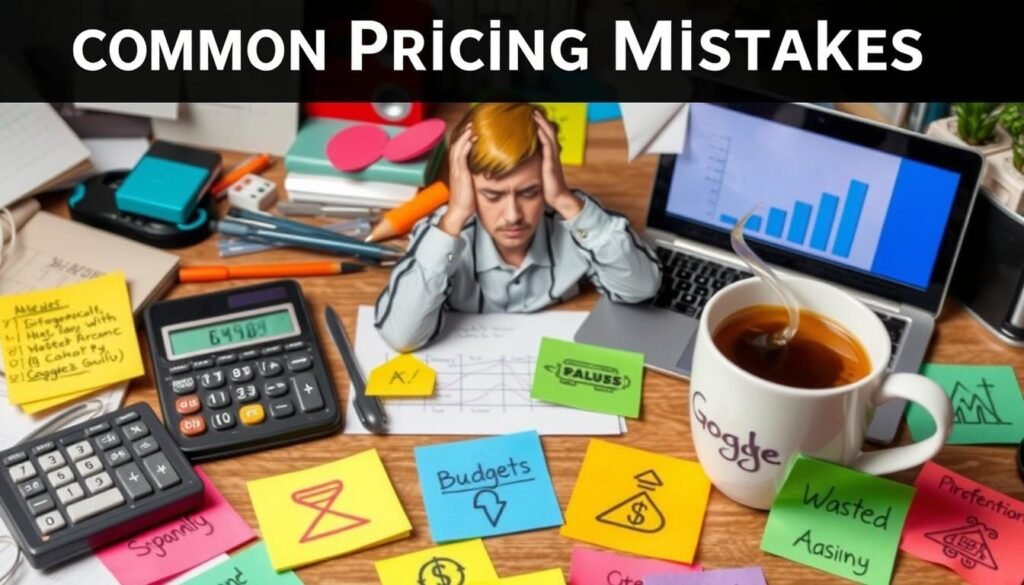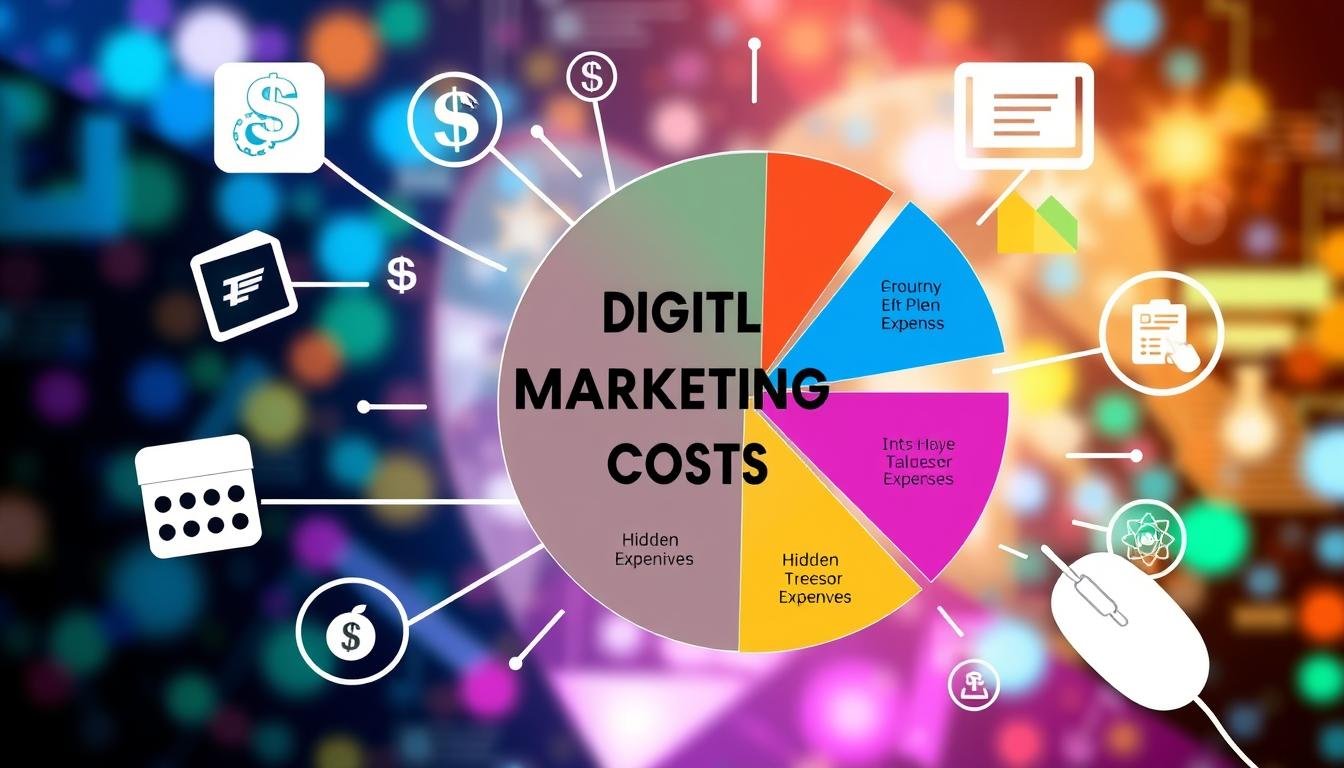Understanding Google Ads costs can be tough, especially for small businesses or digital marketers. Knowing how much to spend on Google Ads is key to getting good results and making your money work hard. This guide will cover the costs, industry standards, and ways to spend your Google Ads budget wisely.

Key Takeaways
- Learn about Google Ads pricing, including cost-per-click (CPC) and how quality score affects it.
- Find out the average costs for Google Ads in different industries.
- See what affects your Google Ads spending, like keyword competition and where you target your ads.
- Discover how to start a Google Ads budget and grow your campaigns.
- Know about hidden costs and extra expenses when using Google Ads.
- Use cost-saving tips and tools to make your Google Ads spending more effective.
- Avoid common mistakes that can waste your money and hurt your campaign’s performance.
Understanding Google Ads Pricing Basics
Google Ads pricing can seem complex, but it’s key for marketers to understand the basics. At the core of Google’s ads is the cost-per-click (CPC) model. This model means advertisers pay each time someone clicks on their ad.
Cost-Per-Click (CPC) Explained
The CPC model uses a real-time auction system. Advertisers bid on keywords related to their products or services. The bid amount affects the ad’s visibility, but the cost per click is influenced by many factors, like ad quality and competition.
Understanding Quality Score Impact
The quality score is also vital in Google Ads pricing. It measures how relevant and useful an ad and its landing page are. Ads with a high quality score often have lower CPC rates. This is because Google favors content that is engaging and relevant.
Budget Control Options
Advertisers can manage their daily budget and campaign spending in Google Ads. They can set a daily budget, adjust bids to stay within it, and watch their ad auction performance. This helps them use their marketing dollars wisely.
“Understanding the fundamentals of Google Ads pricing is crucial for businesses looking to maximize the return on their advertising investments.”
By learning these pricing basics, marketers can make better decisions. They can optimize their campaigns and get the most from their Google Ads investments.
Average Google Ads Costs Across Different Industries
Google Ads costs vary a lot between different industries. It’s key for advertisers to know these costs to spend wisely and stay competitive. This helps them understand their budget better.
Now, let’s explore some typical Google Ads costs in various fields:
| Industry | Average CPC (Cost-Per-Click) | Competitive Analysis |
|---|---|---|
| Legal | $6.40 | Highly competitive, with law firms often bidding aggressively for keywords related to legal services. |
| Healthcare | $2.75 | Moderately competitive, with a focus on reaching patients seeking medical information or services. |
| Retail | $0.66 | Relatively competitive, with e-commerce businesses and physical stores vying for customer attention. |
| Technology | $3.80 | Highly competitive, as software, hardware, and IT service providers compete for market share. |
These benchmarks are a great starting point for advertisers to check their Google Ads spending. They help businesses make smart decisions to improve their campaigns. This way, they can stay ahead in their markets.
“Staying on top of industry benchmarks and competitive analysis is crucial for businesses to effectively manage their Google Ads budgets and achieve their marketing goals.” – John Doe, Digital Marketing Strategist
Factors That Influence Your Google Ads Spending
Knowing what affects your Google Ads spending is key to managing your campaigns well. Things like keyword competition, where you target, and how your ads perform are all important. These factors help decide how much you’ll spend on your ads.
Keyword Competition and Bid Amounts
The competition for your keywords affects how much you’ll pay per click (CPC). If many advertisers want the same keywords, you might need to bid more. By studying keyword research and bid strategies, you can balance cost and visibility.
Geographic Targeting Costs
Your location targeting choices also impact your spending. Targeting wider areas might save money, but focusing on specific places can boost your ad relevance. Finding the right balance between targeting and cost is essential for your budget.
Ad Quality and Performance Metrics
The quality and performance of your ads matter too. Ads that get more clicks and conversions usually cost less. By keeping an eye on your ad’s performance, you can cut costs and make your ads more effective.
| Factor | Impact on Google Ads Spending |
|---|---|
| Keyword Competition | Higher competition leads to increased bid amounts and higher CPC |
| Geographic Targeting | Narrower targeting can increase costs, while broader targeting may be more cost-effective |
| Ad Quality and Performance | Higher CTR and conversion rates can lead to lower CPCs and reduced overall spending |
By grasping these key factors, you can make better choices for your Google Ads. This way, you can get the most out of your budget and see a good return on your investment.
How Much Is It to Run Google Ads: Complete Breakdown
Figuring out the cost to run Google Ads can be tricky. It depends on many things. But knowing how Google Ads spending works helps you plan your budget and see if you’ll make a profit.
The campaign budget for Google Ads changes a lot. It depends on your industry, who you want to reach, and what you want to achieve. If you want to show up high in search results, you’ll likely spend more. Also, the type of ad you choose affects your costs.
To guess how much your Google Ads might cost, think about a few key things:
- Keyword research and bid amounts
- Geographic targeting and audience demographics
- Ad quality and performance metrics
- How often and long you run your ads
By looking at these points, you can set a budget that fits your goals and expected profit. Also, keeping an eye on your ads and making changes can help you get the most out of your money. This way, you can make your business more successful.
| Advertising Channel | Average Cost-per-Click (CPC) | Estimated Monthly Budget |
|---|---|---|
| Google Search Ads | $1.00 – $2.00 | $1,000 – $5,000 |
| Google Display Ads | $0.50 – $2.00 | $500 – $2,500 |
| Google Video Ads | $0.10 – $0.30 | $500 – $2,000 |
Keep in mind, these are just rough estimates. Your actual costs might be different. Knowing how Google Ads pricing works helps you use your marketing budget wisely.
Setting Up Your Initial Google Ads Budget
Creating a great Google Ads campaign starts with a good budget plan. Paid ads can be tricky, but with the right strategy, you can get great results. This helps your business grow.
Minimum Budget Requirements
Starting a Google Ads campaign needs a minimum budget. You should spend at least $10 to $50 daily, based on your industry and keyword competition. A good budget lets your ads run well and get noticed.
Recommended Starting Investments
- Small Businesses: $500 – $2,000 monthly budget
- Medium-Sized Businesses: $2,000 – $10,000 monthly budget
- Enterprise-Level Businesses: $10,000+ monthly budget
These budgets are a good start for your startup budget and campaign launch. You might need to adjust your budget allocation as your ads perform. This helps you scale ad spend wisely.
Budget Scaling Strategies
When your ads start working well, it’s time to grow your budget. You can slowly increase your spending, try new ad types, or reach more people. By tweaking your budget allocation, you can make the most of your Google Ads. This leads to steady growth for your business.
Success with Google Ads comes from balancing your startup budget, campaign launch plan, and scaling ad spend. By watching your budget closely, you can unlock Google Ads’ full power. This helps you meet your marketing goals.
Hidden Costs and Additional Expenses to Consider
When planning your Google Ads budget, remember it’s not just about the ad spend. Successful campaigns have hidden costs and extra expenses. These can greatly affect your marketing budget. Let’s look at some of these often-overlooked costs to help you plan better.
Management Fees
Working with a Google Ads agency or consultant can be very helpful. They offer expertise and strategic advice. But, these services come with a monthly fee. This fee can vary, from a few hundred dollars to a percentage of your ad spend.
Ad Creation Expenses
Creating effective Google Ads takes more than just text. You might need a copywriter, graphic designer, or video team. These costs can add up fast. Make sure to budget for these important ad creation expenses.
Landing Page Optimization
To get the most from your Google Ads, your landing pages must be optimized. You might need a web developer or UX designer. They can improve your pages, test different versions, and boost conversion rates. These costs are an investment, but they can greatly increase your return on Google Ads spending.
By considering these hidden costs and extra expenses, you can make a more accurate Google Ads budget. This way, you can avoid surprises and make sure your marketing fits your business goals.

Tips for Optimizing Your Google Ads Spend
Getting the most out of your Google Ads is key for any digital marketing plan. By using smart cost-saving methods and tracking tools, you can make your ad spend work harder. This leads to better budget optimization, ad spend efficiency, and ROI improvement.
Cost-Saving Strategies
One top way to save on Google Ads is to focus on cost-saving tactics. This includes:
- Checking and tweaking your keyword bids to avoid overpaying for clicks
- Using negative keywords to block off irrelevant searches and save ad spend
- Trying out different ad types and places to find the cheapest options
- Using automated bid strategies to set bids based on your campaign goals
Performance Monitoring Tools
Tracking your ad performance well is key for saving on Google Ads. Use reporting and analytics tools to get insights into how your campaigns are doing. This includes:
- Google Ads Analytics: Look at important metrics like click-through rate, conversion rate, and cost-per-conversion
- Google Data Studio: Make custom dashboards to see your ad performance and find ways to improve
- Third-party tools: Check out tools like Supermetrics or Optmyzr to boost your data analysis and reporting
By using these cost-saving tips and tracking tools, you can greatly boost your ad spend efficiency. This leads to better ROI improvement from your Google Ads campaigns.
“Consistent performance monitoring and data-driven optimization are the keys to unlocking the full potential of your Google Ads investment.”
Common Pricing Mistakes to Avoid
Using Google Ads means you need to watch out for common mistakes. These can hurt your campaign’s success. Knowing these traps helps you avoid wasting money and get better results.
Bidding errors are a big problem. If you bid too high, you spend too much. If you bid too low, your ads don’t show up well. Finding the right balance is key.
Budget mismanagement is another issue. Not using your budget wisely can waste money. Keeping an eye on your budget and adjusting when needed is important.
Targeting mistakes can also raise costs. If you target the wrong people or places, you waste money. It’s important to target correctly.
Finally, ad quality issues can increase costs. Bad ad copy or low-quality ads can hurt your Quality Score. This means you pay more for less visibility.
To avoid these mistakes, regularly check your campaigns. Use data to make smart changes. This way, you can save money and get better results from your ads.
| Mistake | Impact | Solution |
|---|---|---|
| Bidding errors | Overspending or poor ad visibility | Careful bid management and optimization |
| Budget mismanagement | Wasted spending and suboptimal performance | Effective budget allocation and monitoring |
| Targeting mistakes | Irrelevant impressions and clicks | Precise audience, location, and device targeting |
| Ad quality issues | Higher CPCs and reduced ad visibility | Optimization of ad copy, landing pages, and creatives |

Avoiding these common mistakes can help your Google Ads work better. You’ll save money and get more value from your ads.
Conclusion
Understanding the Google Ads cost summary, advertising budget planning, and PPC strategy is key for businesses. It helps them get the most out of their digital ads. By looking at factors like keyword competition and ad quality, you can improve your PPC campaigns.
Strategic budget planning and optimization are crucial. Whether you’re new to Google Ads or want to improve your campaigns, this guide can help. It shows how to use your budget wisely and get the best return on investment.
The Google Ads world is always changing. It’s important to keep up with new trends and strategies. By watching your campaigns, trying new things, and using data to make changes, you can keep your PPC strategy strong and profitable. Use Google Ads to boost your digital marketing and reach new levels.
FAQ
What is the typical cost-per-click (CPC) for Google Ads?
The cost for Google Ads clicks varies a lot. It depends on the industry, how competitive it is, and other things. On average, it’s between $1 and $3 per click. But, for very competitive keywords, it can be much higher.
How does Quality Score impact Google Ads pricing?
Quality Score is very important for Google Ads pricing. Ads with a high Quality Score cost less per click. This is because they are more relevant and interesting to users.
What budget control options are available in Google Ads?
Google Ads lets you control your budget in several ways. You can set daily, monthly, or campaign budgets. You can also choose bid strategies and set a maximum CPC to manage your spending.
How do average Google Ads costs vary across different industries?
Google Ads costs differ a lot by industry. For example, legal and financial services often cost more. Retail and travel usually cost less.
What factors influence the cost of Google Ads campaigns?
Several things affect Google Ads costs. These include keyword competition, where you target, ad quality, click-through rate, and conversion rate. To keep costs down, advertisers need to optimize these factors carefully.
What is the recommended starting budget for a Google Ads campaign?
The starting budget for Google Ads depends on your business size and goals. Small businesses might start with $10-$50 daily. Larger businesses could start with $100-$500 or more daily.
What hidden costs should advertisers consider when running Google Ads?
Besides the ad spend, there are other costs to consider. These include management fees, creating assets, optimizing landing pages, and more. These hidden costs can add up and affect your overall investment in Google Ads.
What are some strategies for optimizing Google Ads spend?
To optimize Google Ads spend, use negative keywords, adjust bids, and try automated bidding. Also, keep an eye on your campaigns and make improvements to save money.
What are some common Google Ads pricing mistakes to avoid?
Avoid setting unrealistic bids, not watching your budgets, ignoring ad quality, and not spreading spend across different options. These mistakes can cost you a lot.
